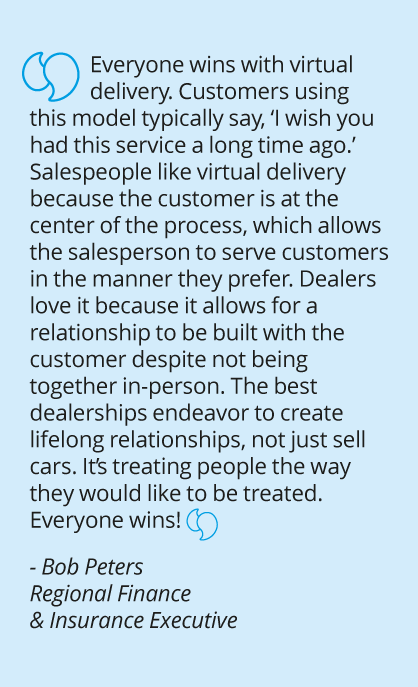Virtual Delivery
Fitzgerald Finds
EARLY SUCCESS WITH VIRTUAL DELIVERY
Virtual delivery has become an essential model for car buying amid the coronavirus pandemic, leveraging technology to replace face-to-face interactions and complete the sales process.
The shift to virtual delivery has resulted in a significant change in the traditional customer-sales interaction.
What can be lost are the human interaction and rapport-building opportunities that are so essential to success, but what can be been gained is a clearer understanding of what customers want.
“When the pandemic hit, many dealers closed their stores to the public,” says Scott Addison, Sales Director of Fitzgerald Auto Mall. “Our initial concern was for our customers’ well-being, so we conducted an outreach campaign to check-in with all of our customers, see if there was anything we could do to help them.” After that initial period, there was also concern for the safety of customers and employees in the dealership.
Scott says, “We did not want anybody to be physically in our stores, so we decided to move to remote (off-site) delivery, which involved working with customers during the sales process by phone and on video platforms, then deliver vehicles to their location."
Kathleen Allen, a Zurich Regional Finance Executive who works with Fitzgerald says, “Early on Scott and I talked about what we needed to do to adapt during COVID. Scott wanted a certification process to ensure every F&I manager in the company received a comprehensive training experience and was ready to execute the virtual delivery model.”
The Zurich team designed a workshop, including best practices for delivering vehicles off-site and using video technology to complete the sales process.
Lindsey Gray, Fitzgerald Settlement Manager says, “Zurich helped us transition to virtual delivery very quickly. They gave us the process and then trained us on how to execute it. Our F&I Executive, Kathleen Allen, outlined the steps in the sales process for this method. She provided the programs we would use, set up the technology and trained us on how to use it. Kathleen drafted a practice review and had every single finance manager go through it. She also trained and role-played with every finance manager. She evaluated us, then shared our results. If results were low, we would have to retest. Kathleen provided feedback throughout the process on things big and small. She pointed out what we were doing well, what we could improve, tips on everything from the position of camera to tone of voice. She did a great job letting us know what to expect and motivating us, and she was our cheerleader. She stayed positive throughout and helped us realize that we were acquiring new skills and tools that we will be able to use going forward.”
A wide variety of technology applications can be used at different points in the virtual delivery process, including phone, text, email, menu product platforms, and video and web conferencing. Knowing when and how to deploy the technology is one of the greatest challenges. Bob Peters, Regional Finance & Insurance Executive, says, “Probably the biggest challenge for Zurich was that we had to become proficient in all of the technology overnight. With virtual delivery, it is critical to see the customer, not just talk by phone. There are a number of video platforms that we can engage, and we had to become skilled in all of them.”
Results are significantly better when using video than phone during the sales process. Video platforms offer tools and screen-sharing options that help it seem more like a customer is sitting in your dealership. Absent that, business managers need to convey the same information strictly using conversation. This takes longer and can be, cumbersome, and largely ineffective. Customers have been introduced to video conferencing through things like face-timing with their friends and family, and virtual physician visits. Many do-it-yourself (DIY) platforms use video, so it is easy to take advantage of the technology to deepen relationships with customers.
Another important tool is the menu product presentation, which can be shared virtually and that allows the customer to be active in choosing protection plans and seeing their pricing update instantaneously. The customer can digitally sign their product agreements directly on their iPad, cell/smartphone, or PC. Signed agreements can be emailed to the customer for retention; eliminating the need for the paperwork in the glove box. Knowing when and how to leverage these tools and how to incorporate them for the customer is critical.
“We are finding virtual delivery to be a highly effective model that we can scale and deliver to all of our dealers,” notes Peters. “Our customers are innovative and are continuously evaluating and adopting new and better processes.”
Addison says, “What we have found is that customers really appreciate this way of doing business. They love having control of the buying process. Customers are beginning to come into our stores again, but what we now know is that if we evolve in this direction, we’ll have more opportunity to win.”
Fitzgerald Auto Mall has stores in Pennsylvania, Maryland and Florida.

11 DEALER PRINCIPAL